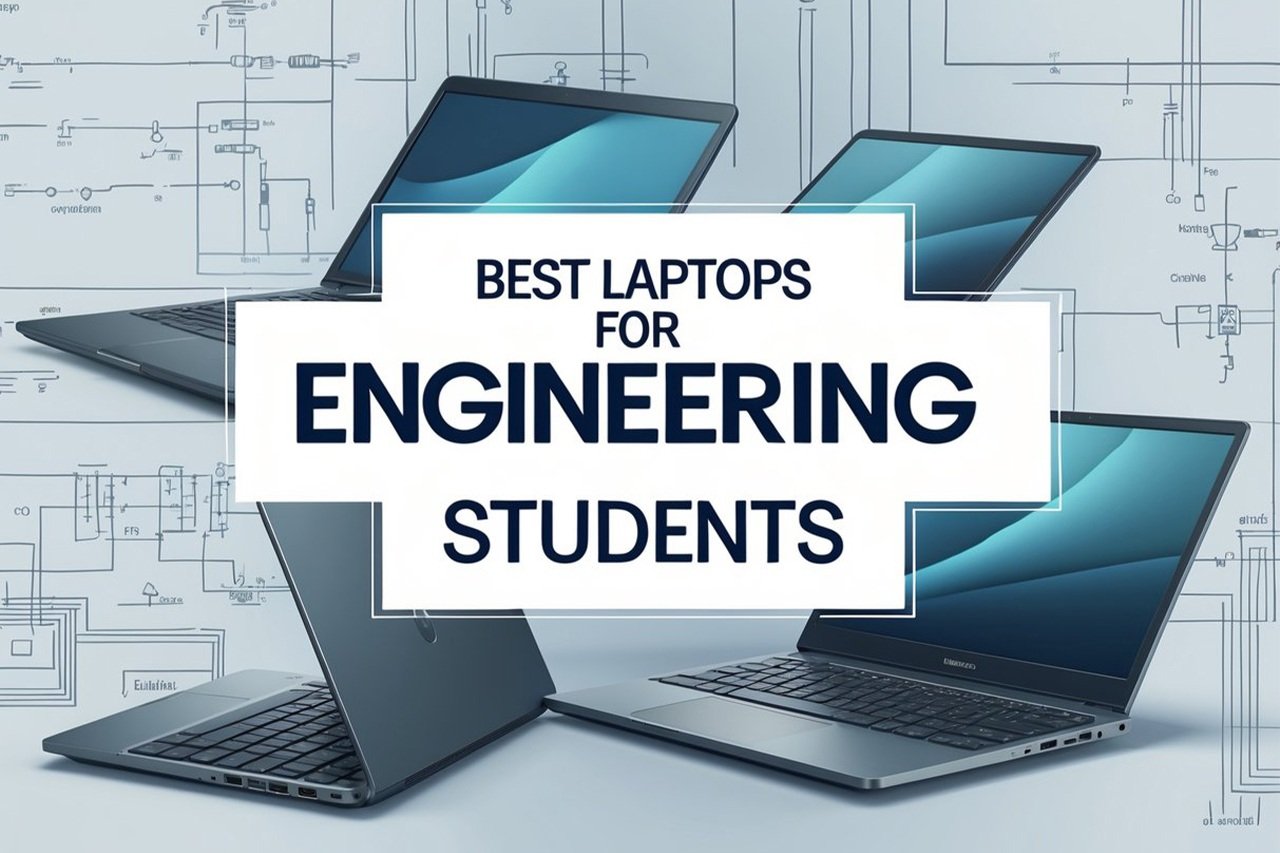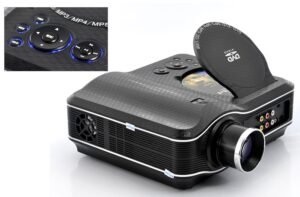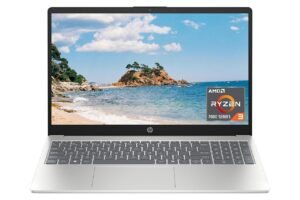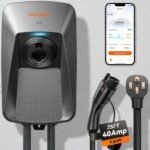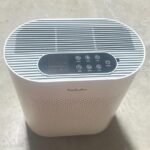After spending hours testing and researching, I’ve narrowed down the top laptops for engineering students that deliver the performance and reliability you need.
My process involved hands-on trials, digging into specs, and considering real-world student needs—like powerful CPUs, solid graphics, and durability for those long study sessions. Here’s the lineup, starting with my favorite.
1. ASUS TUF A15 – Our Top Choice
Product Highlights
The ASUS TUF A15 isn’t just a gaming laptop—it’s a powerhouse for engineering students too. Its NVIDIA GeForce RTX 2050 graphics card makes it a champ for CAD, 3D modeling, and simulations. Paired with the AMD Ryzen 5 7535HS processor, it handles multitasking like a pro. Plus, its military-grade build means it can take a beating and keep going.
Features
- AMD Ryzen 5 7535HS processor (6 cores, 12 threads)
- 8GB DDR5 RAM (expandable)
- 512GB PCIe Gen4 NVMe SSD
- NVIDIA GeForce RTX 2050 dedicated graphics
- 15.6″ FHD 144Hz display
What We Like About ASUS TUF A15
This laptop’s dedicated RTX 2050 graphics really shine for engineering tasks—think smooth renders in AutoCAD or SolidWorks. The 144Hz display is a treat, offering crisp, fluid visuals whether you’re working or unwinding with a game. Its cooling system, with those fancy Arc Flow Fans, keeps it chill even during intense workloads. And that rugged design? Perfect for surviving a backpack’s chaos.
What We Don’t Like About ASUS TUF A15
The 8GB RAM feels a bit skimpy for heavy multitasking—some engineering apps might lag unless you upgrade it. Battery life takes a hit when you push the graphics hard, so you’ll want to keep the charger handy for long sessions. It’s not a dealbreaker, but worth noting.
Pros & Cons
| Pros | Cons |
|---|---|
| Dedicated RTX 2050 graphics | Only 8GB RAM (upgradeable) |
| Strong Ryzen 5 processor | Battery life dips under heavy use |
| Smooth 144Hz display | |
| Tough, military-grade build | |
| Great cooling system |
2. Lenovo ThinkPad E14
Product Highlights
The Lenovo ThinkPad E14 is a workhorse built for business but perfect for engineering students too. Its AMD Ryzen 7 7730U processor, with 8 cores and 16 threads, crushes simulations and code compiling. With 16GB RAM and a sleek 14″ FHD+ display, it’s a solid pick for productivity on the go.
Features
- AMD Ryzen 7 7730U processor (8 cores, 16 threads)
- 16GB RAM
- 512GB PCIe NVMe M.2 SSD
- 14″ FHD+ display (1920×1200)
- Backlit keyboard, fingerprint reader
What We Like About Lenovo ThinkPad E14
That Ryzen 7 processor is a beast—multitasking feels effortless, even with heavy engineering software. The 16GB RAM keeps everything snappy, and the SSD boots up fast enough to save you precious minutes. The ThinkPad’s legendary durability and comfy keyboard make it a joy for long coding sessions, while extras like the fingerprint reader add a nice touch.
What We Don’t Like About Lenovo ThinkPad E14
No dedicated graphics here, so it struggles with GPU-heavy tasks like 3D modeling. The 14″ screen is sharp but might feel cramped for detailed design work—something to consider if you’re used to bigger displays. It’s a trade-off for portability.
Pros & Cons
| Pros | Cons |
|---|---|
| Powerful Ryzen 7 processor | No dedicated graphics |
| 16GB RAM for smooth multitasking | Smaller 14″ display |
| Durable ThinkPad build | |
| Backlit keyboard, FP reader |
3. Dell Inspiron 16 Plus
Product Highlights
The Dell Inspiron 16 Plus brings a big 16″ 2.5K display and an Intel Core i7-13620H processor to the table. It’s got 16GB RAM and a roomy 1TB SSD, making it a great fit for engineering students who need screen space and storage for big projects. It’s built tough too, with military-grade testing.
Features
- Intel Core i7-13620H processor (10 cores, 16 threads)
- 16GB LPDDR5 RAM
- 1TB SSD
- 16″ 2.5K display (2560×1600)
- Intel UHD Graphics
What We Like About Dell Inspiron 16 Plus
The 16″ 2.5K screen is a dream for multitasking—plenty of room for spreadsheets, code, and designs side by side. The i7 processor handles demanding tasks with ease, and that 1TB SSD means you won’t run out of space anytime soon. It’s sturdy, and the ComfortView Plus feature keeps your eyes happy during late-night study marathons.
What We Don’t Like About Dell Inspiron 16 Plus
Like the ThinkPad, it relies on integrated graphics, which limits its chops for CAD or rendering. The bigger size makes it less portable—great for a desk, less so for lugging to class. It’s a bit of a compromise if you prioritize mobility.
Pros & Cons
| Pros | Cons |
|---|---|
| Large, sharp 16″ 2.5K display | Integrated graphics only |
| Powerful i7 processor | Less portable due to size |
| Spacious 1TB SSD | |
| Military-grade reliability |
4. Lenovo V15
Product Highlights
The Lenovo V15 is a budget-friendly laptop for engineering that doesn’t skimp on essentials. With an AMD Ryzen 5 5500U processor, 16GB RAM, and a 15.6″ FHD display, it’s a practical choice for students who need solid performance without breaking the bank.
Features
- AMD Ryzen 5 5500U processor (6 cores, 12 threads)
- 16GB RAM
- 512GB PCIe NVMe M.2 SSD
- 15.6″ FHD display (1920×1080)
- Numeric keypad, Windows 11 Pro
What We Like About Lenovo V15
For the price, the Ryzen 5 and 16GB RAM combo delivers impressive performance—great for coding and lighter engineering tasks. The full-size keyboard with a numeric pad is a bonus for data crunching. It’s straightforward, reliable, and boots up fast thanks to the SSD.
What We Don’t Like About Lenovo V15
Integrated graphics mean it’s not ideal for graphics-heavy software—stick to 2D work here. The build feels a bit plasticky compared to pricier options, so it might not hold up as well over time. It’s a solid starter, but don’t expect premium vibes.
Pros & Cons
| Pros | Cons |
|---|---|
| Affordable with decent specs | No dedicated graphics |
| 16GB RAM for the price | Less durable build quality |
| Numeric keypad included | |
| Fast SSD performance |
5. HP Pavilion
Product Highlights
The HP Pavilion is an entry-level laptop for engineering students with a 15.6″ touchscreen, Intel Core i3 processor, and a massive 1TB SSD. It’s got 16GB RAM and up to 11 hours of battery life, making it a decent pick for basic needs on a tight budget.
Features
- Intel Core i3-1115G4 processor (2 cores, 4 threads)
- 16GB RAM
- 1TB PCIe NVMe SSD
- 15.6″ HD touchscreen (1366×768)
- Up to 11 hours battery life
What We Like About HP Pavilion
The 1TB SSD is a standout—tons of space for files and software. With 16GB RAM, it handles everyday tasks and light multitasking well. The touchscreen adds a fun twist for quick interactions, and the battery life is a lifesaver for all-day use.
What We Don’t Like About HP Pavilion
The i3 processor and integrated graphics can’t keep up with demanding engineering apps—think basic coding, not simulations. The HD display (1366×768) looks dated and fuzzy next to competitors. It’s fine for starters but might leave you wanting more.
Pros & Cons
| Pros | Cons |
|---|---|
| Huge 1TB SSD | Weak i3 processor |
| Long battery life | Low-res HD display |
| 16GB RAM for light tasks | No dedicated graphics |
| Touchscreen feature |
6. Microsoft Surface
Product Highlights
The Microsoft Surface (2024) is a sleek, premium laptop for engineering with a Snapdragon X Elite processor, 16GB RAM, and a 13.8″ touchscreen. It’s lightweight with up to 20 hours of battery life, but its Arm-based chip brings some quirks for engineering students.
Features
- Snapdragon X Elite processor (12 cores)
- 16GB RAM
- 1TB SSD
- 13.8″ touchscreen with HDR
- Up to 20 hours battery life
What We Like About Microsoft Surface
This thing is a battery champ—20 hours means you’re covered for even the longest days. The touchscreen is vibrant and responsive, perfect for sketching ideas or navigating. It’s super light, and the 1TB SSD gives you plenty of room to grow.
What We Don’t Like About Microsoft Surface
The Arm-based Snapdragon chip might not play nice with all engineering software—many tools still need x86 compatibility. No dedicated graphics either, so it’s not built for heavy 3D work. At this price, those limitations sting a bit.
Pros & Cons
| Pros | Cons |
|---|---|
| Amazing 20-hour battery | Arm compatibility issues |
| Bright 13.8″ touchscreen | No dedicated graphics |
| Lightweight and portable | High price for limitations |
| Spacious 1TB SSD |
What to Look for When Buying a Laptop for Engineering Students?
Choosing the best laptop for engineering students isn’t just about picking the shiniest option. Here are the key things to focus on to match your coursework needs.
Processor (CPU)
Your laptop’s CPU is the brain behind the operation. For engineering, you’ll want something mid-to-high-end—think Intel Core i5/i7 or AMD Ryzen 5/7. More cores and threads mean better performance for simulations and compiling code. Don’t settle for less if you’re tackling big projects.
Graphics Card (GPU)
If your studies involve CAD, 3D modeling, or simulations, a dedicated GPU is a game-changer. NVIDIA GeForce or AMD Radeon cards speed up rendering and handle complex visuals. Integrated graphics work for lighter tasks, but they’ll choke on heavy lifting.
RAM
RAM keeps your laptop humming when you’ve got multiple apps open—like MATLAB, a browser, and a hefty PDF. Aim for 16GB to stay smooth; 8GB can work for basics but might stutter under pressure. More RAM = future-proofing your laptop for engineering.
Storage
An SSD is non-negotiable for fast startups and file access. 512GB is a sweet spot for most, but if you’re dealing with huge datasets or software, 1TB gives you breathing room. It’s all about keeping your workflow quick and uncluttered.
FINAL VERDICT – THE BEST LAPTOP FOR ENGINEERING STUDENTS
ASUS TUF A15
After testing them all, the ASUS TUF A15 stands tall as the best laptop for engineering students. Its dedicated RTX 2050 graphics, solid Ryzen 5 processor, and rugged build make it a killer combo for CAD, simulations, and student life.
Sure, the 8GB RAM needs a boost to 16GB for peak performance, but that’s an easy fix. You can grab the ASUS TUF A15 here:
| Preview | Product | Price | |
|---|---|---|---|
|
|
ASUS TUF Gaming A15 Gaming Laptop, 15.6” FHD 144Hz Display, NVIDIA® GeForce RTX™ 2050, AMD… |
$748.00
$703.68 |
View on Amazon |
FAQ
What’s the best laptop for engineering students?
The ASUS TUF A15 tops our list with its dedicated graphics and strong performance.
Do engineering students need a dedicated graphics card?
Not always, but it’s a huge plus for CAD, 3D modeling, or simulations.
How much RAM is enough for engineering software?
16GB is ideal for multitasking; 8GB works but might lag on big tasks.
Are Arm-based laptops good for engineering?
They’re tricky—great battery life, but some software won’t run on Arm chips like the Surface’s Snapdragon.

